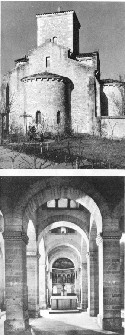
|
The kingdom ruled over by Charlemagne’s father, Pepin the Short, extended from the North Sea to the Pyrenees and from Brittany to the Danube River. After the deaths of his father and his brother, Carloman, Charlemagne became sole ruler of a territory which included most of western and central Europe.
In this vast area lived a variety of peoples. The original Franks occupied the northwest part of the kingdom, with the Visigoths, Burgundians and German tribes as their neighbors.
The Visigoths, originally from near the Black Sea, had migrated to Italy in the fifth century and later settled in what is today southern France and Spain. In Charlemagne’s day, their descendants occupied the area north of the Pyrenees along the Atlantic coast. The Burgundians had in the fifth century settled in the central region bordering on the Rhone River. They had their own laws and even their own king, although they were in reality subject to Frankish political power. The German population, which had many times proved rebellious under Charlemagne’s ancestors, inhabited the eastern part of the kingdom along the Danube Valley as far as present-day Hungary.
Beyond the borders of the Frankish kingdom, three main powers shared what had once been the Roman empire. In Italy a complex situation existed. A Germanic people called the Lombards occupied most of the northern part of the peninsula, from the Alps to the Ionian Sea. The southern part of the peninsula remained in the hands of the dying Byzantine empire, whose capital was Constantinople. In between lay an area which included the exarchate of Ravenna, the Pentapolis, the duchy of Perugia and the duchy of Rome, in which the interests of the Lombards, the Byzantines and the papacy in Rome overlapped.
Outside Italy, Byzantium still controlled an empire which included what is today Yugoslavia, Albania, Greece, Bulgaria, Turkey and the islands of the Aegean Sea. To the north its borders were constantly menaced by the Slavs while to the east the Moslems, the great rising power of the seventh century, threatened further encroachments. The Moslems were in control of northern Africa and the Iberian peninsula. More serious for the economy of western Europe, they had closed off the western Mediterranean to Frankish trade.
Religious divisions roughly corresponded to the political outline of seventh century Europe. In Italy and the Frankish kingdom, Christianity directed from Rome prevailed. In the Greek-speaking Byzantine empire, the Christian population followed the authority of the patriarch of Constantinople. The rest of the Mediterranean world was Islamic.

|
The political control which Charlemagne exerted over his conquered territories was sufficient to revive the concept of a western Roman empire, over which the Frankish king was crowned emperor in 800.In the ninth century, churches and abbeys were resting places for travelers through-out the Carolingian empire. Pictured: exterior and interior views of the chapel at Germigny-des-Pres, which was built in 806 by Theodolf, a member of Charlemagne’s Palatine Academy.
Once he inherited the throne, Charlemagne began to increase the dominion of his already large realm. He pushed the Moslems back from the Pyrenees and occupied the Spanish cities of Pamplona and Barcelona. Most of the Italian peninsula, with the exception of Venice, Istria and certain regions in the extreme south, became a Frankish possession. In the east the vast Avar territory was absorbed into the empire and the Saxons inhabiting the northern reaches of the Elbe were also defeated. In the west Brittany maintained its independence, although Charlemagne’s descendants considered it part of their possessions.